
South Africa occupies the southern tip of Africa, its coastline stretching more than 2,850 kilometres from the desert border with Namibia on the Atlantic (western) coast southwards around the tip of Africa and then northeast to the border with Mozambique on the Indian (eastern) coast. The low-lying coastal zone is narrow for much of that distance, soon giving way to a mountainous escarpment that separates the coast from the high inland plateau. In some places, notably the province of KwaZulu-Natal in the east, a greater distance separates the coast from the escarpment. Although much of the country is classified as semi-arid, it has considerable variation in climate as well as topography. The total land area is 1,220,813 km2 (471,359 sq mi). It has the 23rd largest Exclusive Economic Zone of 1,535,538 km2 (592,875 sq mi).
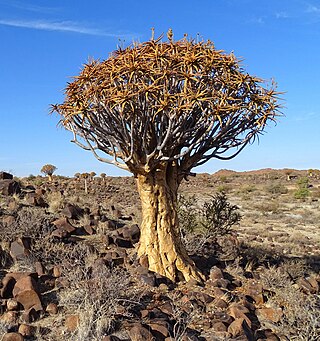
Aloidendron dichotomum, formerly Aloe dichotoma, the quiver tree or kokerboom, is a tall, branching species of succulent plant, indigenous to Southern Africa, specifically in the Northern Cape province of South Africa, and parts of Southern Namibia.

Gonialoe variegata, also known as tiger aloe and partridge-breasted aloe, is a species of flowering plant in the family Asphodelaceae. It is an evergreen succulent perennial indigenous to South Africa and Namibia. It is common in cultivation.

Gasteria is a genus of succulent plants, native to South Africa and the far south-west corner of Namibia.

Aloe arborescens, the krantz aloe or candelabra aloe, is a species of flowering succulent perennial plant that belongs to the genus Aloe, which it shares with the well known and studied Aloe vera. The specific epithet arborescens means "tree-like". Aloe arborescens is valued by gardeners for its succulent green leaves, large vibrantly-colored flowers, winter blooming, and attraction for birds, bees, and butterflies.

The Richtersveld is a desert landscape characterised by rugged kloofs and high mountains, situated in the north-western corner of South Africa’s Northern Cape province. It is full of changing scenery from flat, sandy, coastal plains, to craggy sharp mountains of volcanic rock and the lushness of the Orange River, which forms the border with neighboring Namibia. The area ranges in altitude from sea level, to 1,377 m (4,518 ft) at Cornellberg. Located in the north-western side of the Northern Cape province in South Africa, the Richtersveld is regarded as the only arid biodiversity hotspot on earth and the majority of the area is inscribed on UNESCO's World Heritage List due to its cultural values.
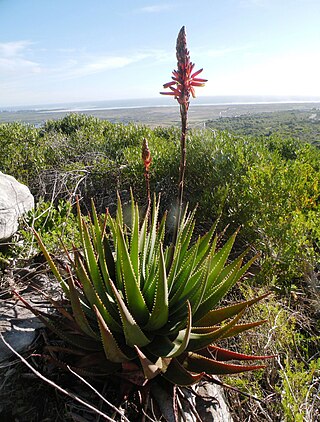
Aloe succotrina, the Fynbos aloe, is an aloe which is endemic to Cape Town and the south-western corner of the Western Cape, South Africa.
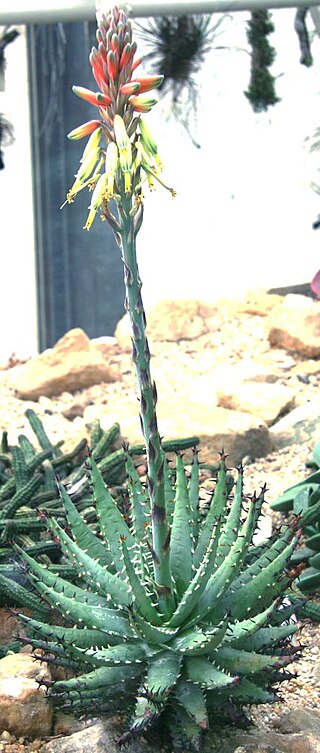
Aloe erinacea is a rare species of succulent plant in the genus Aloe, from arid areas of Namibia.

Aloidendron ramosissimum, or the maiden’s quiver tree, is a species of endangered succulent flowering plant in the family Asphodelaceae found in southern Africa.

²

The ǀAi-ǀAis/Richtersveld Transfrontier Park is a peace park straddling the border between South Africa and Namibia. It was formed in 2003 by combining the Namibian ǀAi-ǀAis Hot Springs Game Park and the South African Richtersveld National Park. Most of the South African part of the park forms part of the buffer zone of the Richtersveld Cultural and Botanical Landscape World Heritage Site, which measures 5,920 square kilometres (2,290 sq mi). The Fish River Canyon, the largest canyon in Africa, is located in the park. A memorandum of understanding was signed on 17 August 2003 by the presidents of South Africa and Namibia, which formalised the establishment of the park. |Ai-|Ais is Khoekhoe for fire-fire, meaning 'hot as fire' or 'scalding hot' named after the hot springs of the same name.

Aloiampelos ciliaris, the common climbing-aloe, is a thin-leaved and generally rapidly-growing succulent plant from Southern Africa.

Aloiampelos gracilis, formerly Aloe gracilis, the rocket aloe, is a succulent plant, endemic to dry thicket vegetation around the city of Port Elizabeth, South Africa. Its natural range lies just to the west of the related Aloiampelos ciliaris, and it occurs in bushy fynbos and dry thickets, and clustered on rocky outcrops at all altitudes. Its range extends westwards into the Baviaanskloof mountains.
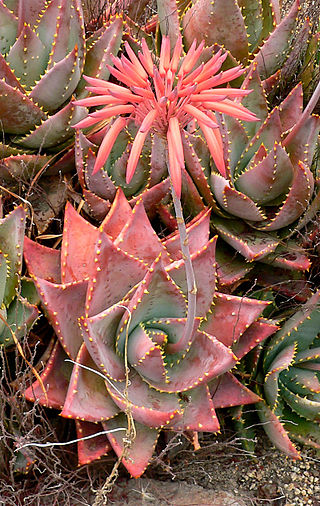
Aloe perfoliata, the rubble aloe or mitre aloe, is a hardy creeping aloe, found in rocky, mountainous areas throughout the Western Cape, South Africa.

Aloiampelos, formerly Aloe ser. Macrifoliae is a genus of succulent plants in the subfamily Asphodeloideae, comprising seven species found in Southern Africa. They are typically multi-branched climbing or sprawling shrubs, with long spindly stems and a large woody base on the ground. These characteristics, as well as their soft, narrow, triangular leaves whose lower part ensheathes the stem, make them easy to distinguish.

Aloe pearsonii is a very distinctive and unusual species of aloe, that is naturally endemic to the arid Richtersveld area on the border between South Africa and Namibia.
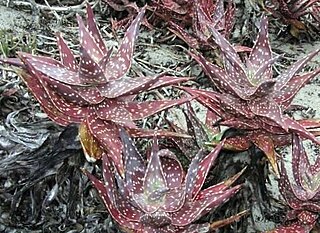
Aloe arenicola is a spotted creeping aloe, indigenous to the arid west coast of South Africa.

Crassula capitella, is a perennial succulent plant native to southern Africa.

Crassula nudicaulis is a succulent plant native to South Africa, and Lesotho.
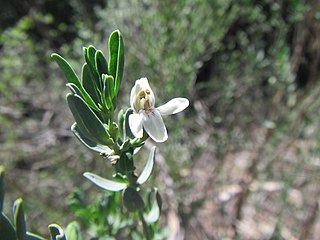
Justicia cuneata is a species of subshrub in the genus Justicia. It is native to Namibia and the Cape Provinces of South Africa.




















